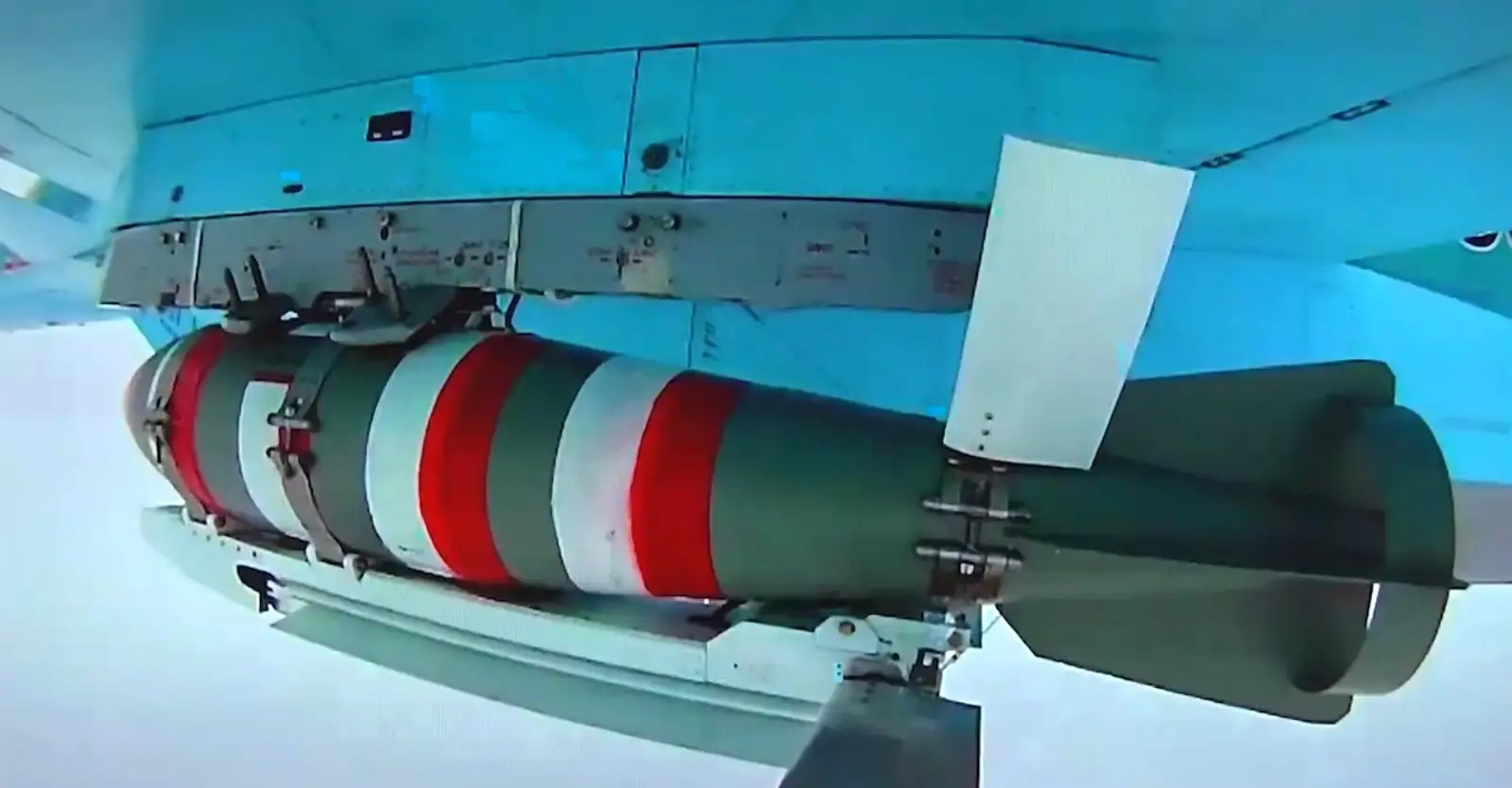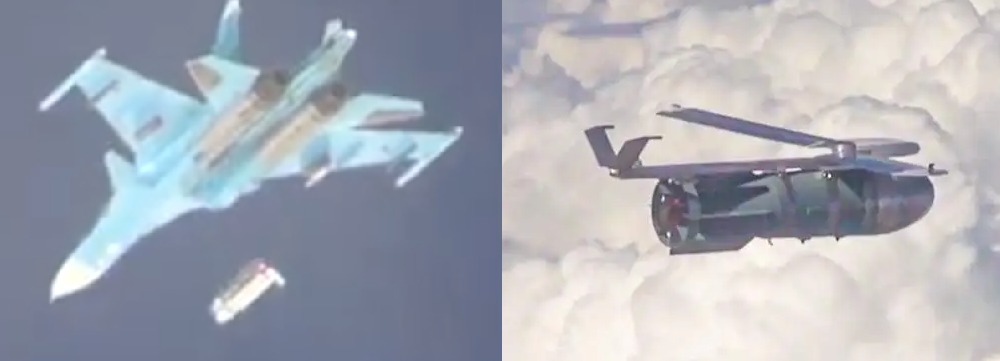At least two videos have gone viral on social media showing Russian UMPK-equipped FAB-500PD bombs striking their targets with deadly precision.
One video shows a salvo of four FAB-500PD bombs hitting an ammunition storage facility in Kherson Oblast. The accuracy of the strike is evident from the secondary explosions that followed the initial impacts. The footage suggests the bombs landed within each other’s lethal blast radius, effectively neutralizing the target.
According to the Russian military-linked Fighterbomber Telegram channel, Russia has introduced an upgraded variant of its UMPK glide and navigation kit for unguided bombs.
This version features an improved Kometa satellite navigation (SATNAV) module, addressing vulnerabilities found in the earlier Kometa-M units used in previous UMPK kits.
UMPK Accuracy Degradation
In February, reports from usually reliable sources suggested that Russian forces had lost a significant battlefield advantage—their ability to deliver precision strikes using UMPK-equipped glide bombs.
On February 25, the Fighterbomber Telegram channel noted that Russian frontline bombers continued to deploy UMPK-equipped bombs against Ukrainian targets with the same frequency as before. However, the accuracy of these munitions had noticeably declined due to degradation in the SATNAV guidance, likely caused by intensified Ukrainian jamming efforts.
When Russian forces first fielded UMPK kits in early 2023, the bombs were equipped with jam-resistant Kometa navigation modules. Following their introduction, Russian social media channels—including the official Telegram account of the Russian Ministry of Defence (RuMoD)—regularly posted videos showcasing UMPK-guided bombs striking targets with high precision.
The integration of UMPK kits significantly enhanced the Russian Air Force’s ability to conduct precision strikes using legacy unguided bombs, offering a cost-effective method to modernize its aerial strike capabilities.
Initially, Ukrainian forces had no effective counter to the UMPK-guided bombs. Their glide time was too short for reliable tracking and interception by most air defense (AD) missile systems.
Yuriy Ihnat, spokesperson for the Ukrainian Air Force, repeatedly acknowledged the challenges posed by UMPK-guided bombs, emphasizing their disruptive impact on Ukrainian defenses.
The relatively low cost of FAB-series bombs, combined with Russia’s vast Soviet-era stockpiles, enabled the deployment of hundreds of UMPK-equipped bombs weekly at the height of their usage, creating a persistent and serious threat to Ukrainian forces and infrastructure.

Electronic Warfare Proves An Effective Counter
Since then, Ukrainian forces have developed portable and mobile electronic warfare (EW) stations capable of degrading the accuracy of the Kometa navigation modules used in UMPK-guided bombs.
These EW systems are reportedly deployed extensively along the line of contact, disrupting satellite-based navigation for various Russian munitions—including UMPK-equipped bombs—thereby diminishing their effectiveness.
On February 26, Forbes reported that Ukrainian forces had acquired the capability to effectively jam Russian glide bombs across the front line, neutralizing one of Russia’s key battlefield advantages.
Following the degradation in the accuracy of UMPK bombs, video footage showing the use of UMPK bombs almost disappeared on social media!
This success highlights the dynamic nature of modern warfare, where electronic countermeasures can play a decisive role in undermining the performance of advanced precision-guided weapons.
Russian Forces Seize The Initiative Again
The two viral videos showing accurate strikes with UMPK-equipped FAB-500 bombs are not isolated incidents. According to the Fighterbomber Telegram channel, Russian forces have carried out numerous strikes along the front lines since April 15.
In each reported case, the strikes were described as accurate by Fighterbomber’s sources.
Not only has the frequency of strikes increased, but each strike has also become more lethal. Russian forces are now launching salvos of two or four glide bombs per attack.
This tactic enhances effectiveness in two key ways: first, the combined explosive payload delivers greater destructive power; second, the spatial separation of the bombs in flight complicates electronic jamming, making it difficult to disrupt the navigation signals of the entire salvo.
The widespread and sustained use of these upgraded UMPK-guided bombs suggests that Russia has both a sufficient stockpile and an active production capacity—potentially producing hundreds of units daily—to support continued deployment at scale.
Make Hay While The Sun Shines
Electronic warfare (EW) is a constant cat-and-mouse game. While Russian forces may have gained the upper hand for now, the balance will inevitably shift. Ukrainian forces will need time to analyze and adapt to the upgraded Kometa modules—but history suggests they eventually will.
This marks the second upgrade to the Kometa module since the start of Russia’s Special Military Operation (SMO).
According to unconfirmed reports, the upgraded Kometa-M module now features 12 to possibly 16 antenna elements. The addition of multiple antenna arrays enhances the system’s ability to spatially distinguish legitimate GNSS (Global Navigation Satellite System) signals from jamming interference, significantly improving resistance to EW.
These additional receivers reportedly allow the module to resist interference “many thousands of times better” than standard GPS-based systems.
This upgrade has created a brief window of opportunity for Russian forces to regain momentum through intensified bombing of Ukrainian storage and staging areas.
The earlier degradation in glide bomb accuracy may have contributed to the stagnation of Russian advances across several fronts since February. As before, the renewed effectiveness of UMPK-equipped bombs could offer Russian forces a chance to alter the battlefield map in their favor.

Conclusion
Several Ukrainian officials, including Volodymyr Zelenskyy, have publicly stated that Russian forces are preparing for a major offensive. These claims are supported by observed military activity, intelligence reports, and independent analyst assessments.
On March 15, Zelenskyy noted that Ukrainian intelligence had detected a buildup of Russian forces, particularly near the Sumy and Kharkiv oblasts.
Further reinforcing this, on April 9, 2025, Ukrainian Commander-in-Chief Oleksandr Syrskyi reported a sharp escalation in Russian military operations. He stated that the rate of Russian assault actions had nearly doubled in just one week across multiple front-line sectors, adding that Russia had “effectively begun an offensive on the Sumy and Kharkiv regions.”
If these assessments prove accurate, the renewed precision and lethality of Russian UMPK-equipped glide bombs could play a significant—if not decisive—role in shaping the outcome of the anticipated offensive.
- Vijainder K Thakur is a retired IAF Jaguar pilot, author, software architect, entrepreneur, and military analyst.
- Follow the author @vkthakur




